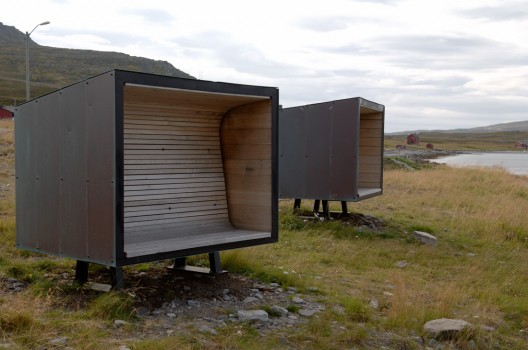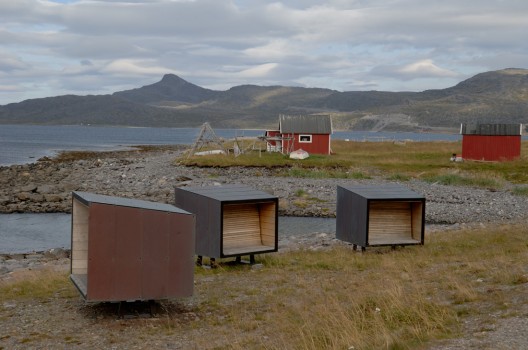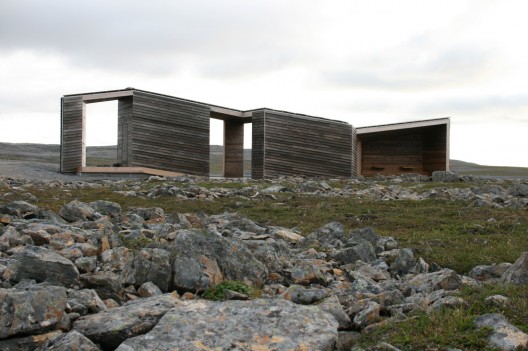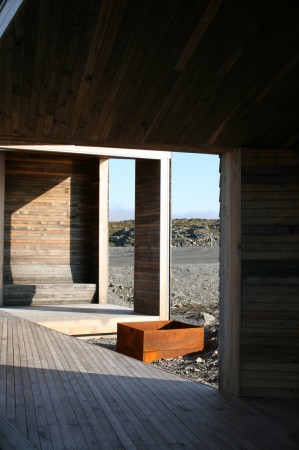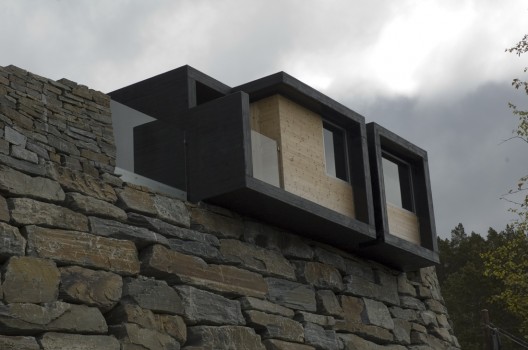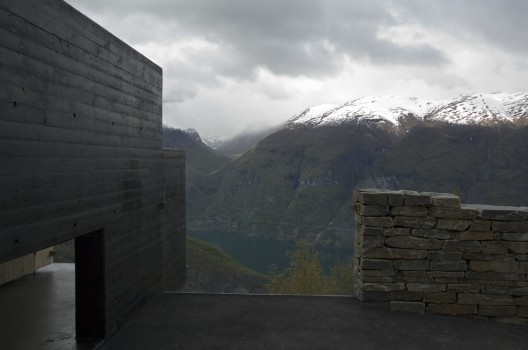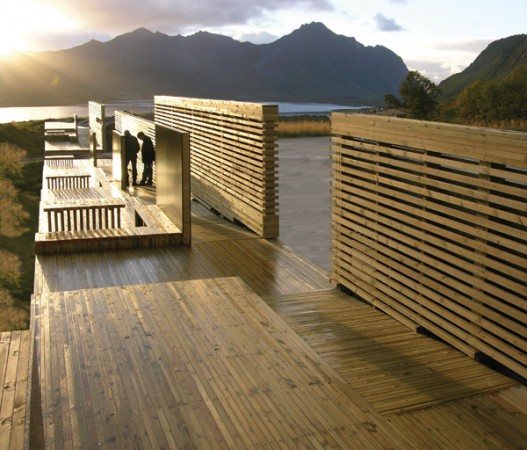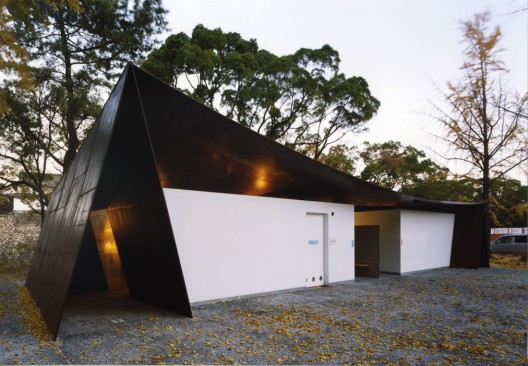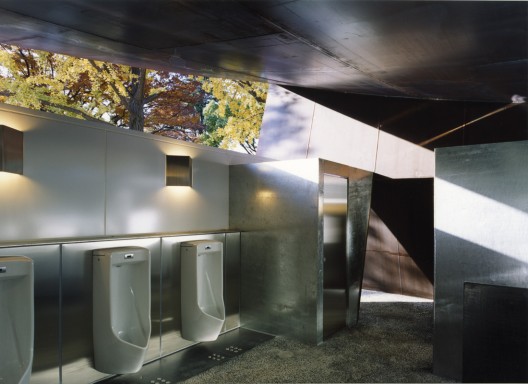adma
Superstar
http://www.good.is/post/rest-stops-rip/
[Interesting photos and comments as well.]
Rest Stops, R.I.P.
Posted by: Emily Badger on June 15, 2009 at 9:08 am
For decades, states have defined themselves through their charming roadside rest stops. Now, they’re losing ground to supersized highway chains. GOOD visits a few of them to figure out what went wrong.
Megan Svajda, a lobbyist for the Virginia Hospitality and Travel Association, is sitting in a smart pantsuit and heels at a shaded picnic table off mile marker 107 on Interstate 95, just north of Richmond. Carloads of vacationing families funnel in and out of the single-story redbrick bathroom behind her. A Greyhound bus pulls up and dumps another two-dozen people into the parking lot and onto the well-tended lawn.
Svajda is here today, off a stretch of otherwise monotonous mega-highway, to show me a rest area she’s been fighting for since the Virginia Department of Transportation began threatening to shut it down earlier this year. “The argument has been made that ‘they’re just toilets,’†she says. “But as you can see, people are walking dogs, eating lunch, stretching their legs, picking up brochures. It’s not just a toilet.â€
Next month, VDOT plans to close this stop and at least 18 of the 40 others in the state, which together serve about 45 million bathroom-breaking travelers a year. Today, there are more than 30 cars in the parking lot and a couple of 18-wheelers out back. When the rest stop is closed, the toilets will be ripped out, the plumbing drained and the electricity cut off. The doors and windows will be boarded up, and the main building surrounded in barbed wire. The off-ramp from the interstate will be barricaded with large concrete boulders. Then the place will just sit here, the weeds overgrowing around a relic of the interstate highway system between Richmond and Washington, D.C.
Across the country, rest areas like this one have been losing a long-fought battle to commercial alternatives, super-sized stops with eight blends of caffeine, free wifi, burgers, and gas. Traditional rest areas cost money to staff and maintain, and aside from the odd vending machine, don’t generate any direct revenue; Virginia expects to save $9 million (much of which has gone to minority- and female-owned maintenance contractors) by not maintaining these buildings. It’s a public expense, originally conceived when the highway system was new and the opportunities to stop far between. That’s harder to justify now that there’s a McDonalds and a gas station at every interchange. The flailing economy today has only made matters worse.
Last year, Louisiana closed 24 of its 34 stops, and Vermont has already shuttered four this year. In April, Wisconsin stopped staffing its welcome centers. South Carolina, meanwhile, is closing its stops two days a week (“budget cuts†say the signs on locked doors) and North Carolina one day a week (“budget shortfallsâ€).
Svajda argues that what’s at stake is not just your ability to hit the bathroom, but a state’s opportunity to make an impression on travelers—to give you the pitch about how Virginia is for Lovers, say. Or about how 400 years ago 103 men and boys crossed the Atlantic in three ships to found English-speaking America here. About how in Virginia, you can explore mountains and rivers and Civil War battlefields, including several just a short drive from this very spot.
A rest area is the only shot locals have to telegraph regional personality to millions of cars just passing through, and it’s been this way for nearly 50 years. The result has been an Americana road tour more revealing than any diner-hopping trip down Route 66: Whatever weird trivia you wanted to know about the geology of Montana, or the plantation history of Mississippi, you can learn at an interstate rest area. They have been a kind of toilet-as-ambassador.
The interstate system was created in 1956 as the Dwight D. Eisenhower National System of Interstate and Defense Highways, and everything about it is perfectly uniform and federally mandated, right down to the width of the dotted white line. Rest areas, however, have been the holdout of states’ rights, most of them designed in a way that’s consistent throughout a state and different from those in the commonwealth next door. Codified in federal jargon as “safety rest areas,†they grew out of the fear that as millions of us took to the road cross-country for the first time, we’d need regular resting outposts to keep us from barreling into each other.
When you’re driving across the Great Plains, the view out the window doesn’t change for days, but at least the architecture of the rest areas does. In Wyoming, where the bathrooms run on solar power, there is a 12-and-a-half-foot bronze bust of Abraham Lincoln at a rest area off I-80. You can visit Vermont’s Vietnam Veterans war memorial at a rest area off I-89, or read about the Oregon Trail crossing I-84 over the Rockies, or the Battle of Bentonville (4,243 wounded, missing, or killed) off I-95 in the North Carolina piedmont. As travelers, we’ve come to judge entire regions of the country—and the people we have never met who live there—on the character and style of their pit stops.
This has always been part of the premise: What the interstate system cost us through efficiency—bypassing Main Streets and unique landscapes in the name of speed—rest areas have tried to give back: a sense of place.
“Part of what you’ve just described is partly due to Jack Kerouac,†says Doug Hecox, a public affairs officer with the Federal Highway Administration. “He takes off on his motorcycle, and one of the conclusions he draws in the book is that America is losing its identity. You can travel on the Interstate from one coast to the other and never see America. It’s all this bleak, anonymous kind of stuff. There are a lot of folks in the engineering community, the highway community, who are not blind to that.â€
And so they gave us teepee picnic shelters in Oklahoma, and oil rig motifs in Texas, and Spanish pueblo bathrooms in New Mexico. In the 1960s and 1970s, when many rest areas were first constructed, that kind of kitsch played to the preconceived romance of different regions. Today, we are a country of long-distance drivers, but the kitsch is no less evocative.
“My memory of rest areas as a kid was that we always stopped at this one midway through our trip near a volcano, Mount Shasta,†says Joanna Dowling, an historian who lives outside of Chicago. This stop was on I-5 in California. “Our mom always read us the information about the volcano, and that was my link. I thought, ‘Oh, I remember that.’ You look forward to it.â€
Dowling grew up to write her master’s thesis at the Art Institute of Chicago on the mid-century architecture embodied in rest areas. “Tell people you’re writing your masters thesis on rest areas,†she jokes, “and they sort of politely have no idea what to say to you.â€
Dowling now has the odd job of advocating for the preservation of buildings that interest more people for their functional use than their historic significance.
“The point is more than just architectural grandeur, or ‘George Washington slept here.’ Those more mainstream understandings [of historic preservation],†she says. “This is a record of the culture of our transportation history, how the interstate system changed the whole dynamic of our country dramatically.â€
If the interstate system is the embodiment of America’s post-World War II movement toward progress, then the rest areas are, as Dowling puts it, the physical manifestation of it.
“Rest stops are a record of the culture of our transportation history, of how the Interstate system changed the whole dynamic of our country dramatically.â€
The Bracey welcome center in Virginia on I-85, about a two-hour drive from the rest area Svajda was touring, is a massive dual-winged colonial building. There is a Virginia flag out front and a white turret on top that might have been used in another era by a Revolutionary on look-out. It is one of the first things drivers see in Virginia after crossing over the border from North Carolina.
“A lot of people think it’s Williamsburg,†says Gloria Rhodes, who staffs the brochure-and-map desk inside. And now if you weren’t already planning to go there, maybe you will. It’s just 115 miles away.
There’s something immensely gratifying about crossing the line into a new state and being immediately confronted by evidence that this place is culturally unique. This rest area, like all of Virginia’s just-over-the-border welcome centers, isn’t on the list to be cut, but the budget shortfalls show in other ways. The staff is only recently back to working seven days a week. Maintenance is also no longer mowing the pet-walking lawn as often.
“And now it’s getting all snakey,†Rhodes says, by which she literally means there are now snakes in the grass.
She seems to understand, as welcome center employees intuitively do, that sometimes we don’t need directions to anywhere, we don’t even need to go to the bathroom; what we need is an excuse to get out of our cars, to talk to another person for the first time in hours about snakes or snow storms or the relative merits of regional rest area architecture.
Rhodes is acutely aware that every detail of this place speaks in some way for t entire state of Virginia.
“That’s why it hurts us so to see the grass growing up. It makes us look—†she pauses for several seconds searching for the right words. “Not manicured. You know how, when your yard is manicured, you look like you have pride in it?â€
[Interesting photos and comments as well.]
Rest Stops, R.I.P.
Posted by: Emily Badger on June 15, 2009 at 9:08 am
For decades, states have defined themselves through their charming roadside rest stops. Now, they’re losing ground to supersized highway chains. GOOD visits a few of them to figure out what went wrong.
Megan Svajda, a lobbyist for the Virginia Hospitality and Travel Association, is sitting in a smart pantsuit and heels at a shaded picnic table off mile marker 107 on Interstate 95, just north of Richmond. Carloads of vacationing families funnel in and out of the single-story redbrick bathroom behind her. A Greyhound bus pulls up and dumps another two-dozen people into the parking lot and onto the well-tended lawn.
Svajda is here today, off a stretch of otherwise monotonous mega-highway, to show me a rest area she’s been fighting for since the Virginia Department of Transportation began threatening to shut it down earlier this year. “The argument has been made that ‘they’re just toilets,’†she says. “But as you can see, people are walking dogs, eating lunch, stretching their legs, picking up brochures. It’s not just a toilet.â€
Next month, VDOT plans to close this stop and at least 18 of the 40 others in the state, which together serve about 45 million bathroom-breaking travelers a year. Today, there are more than 30 cars in the parking lot and a couple of 18-wheelers out back. When the rest stop is closed, the toilets will be ripped out, the plumbing drained and the electricity cut off. The doors and windows will be boarded up, and the main building surrounded in barbed wire. The off-ramp from the interstate will be barricaded with large concrete boulders. Then the place will just sit here, the weeds overgrowing around a relic of the interstate highway system between Richmond and Washington, D.C.
Across the country, rest areas like this one have been losing a long-fought battle to commercial alternatives, super-sized stops with eight blends of caffeine, free wifi, burgers, and gas. Traditional rest areas cost money to staff and maintain, and aside from the odd vending machine, don’t generate any direct revenue; Virginia expects to save $9 million (much of which has gone to minority- and female-owned maintenance contractors) by not maintaining these buildings. It’s a public expense, originally conceived when the highway system was new and the opportunities to stop far between. That’s harder to justify now that there’s a McDonalds and a gas station at every interchange. The flailing economy today has only made matters worse.
Last year, Louisiana closed 24 of its 34 stops, and Vermont has already shuttered four this year. In April, Wisconsin stopped staffing its welcome centers. South Carolina, meanwhile, is closing its stops two days a week (“budget cuts†say the signs on locked doors) and North Carolina one day a week (“budget shortfallsâ€).
Svajda argues that what’s at stake is not just your ability to hit the bathroom, but a state’s opportunity to make an impression on travelers—to give you the pitch about how Virginia is for Lovers, say. Or about how 400 years ago 103 men and boys crossed the Atlantic in three ships to found English-speaking America here. About how in Virginia, you can explore mountains and rivers and Civil War battlefields, including several just a short drive from this very spot.
A rest area is the only shot locals have to telegraph regional personality to millions of cars just passing through, and it’s been this way for nearly 50 years. The result has been an Americana road tour more revealing than any diner-hopping trip down Route 66: Whatever weird trivia you wanted to know about the geology of Montana, or the plantation history of Mississippi, you can learn at an interstate rest area. They have been a kind of toilet-as-ambassador.
The interstate system was created in 1956 as the Dwight D. Eisenhower National System of Interstate and Defense Highways, and everything about it is perfectly uniform and federally mandated, right down to the width of the dotted white line. Rest areas, however, have been the holdout of states’ rights, most of them designed in a way that’s consistent throughout a state and different from those in the commonwealth next door. Codified in federal jargon as “safety rest areas,†they grew out of the fear that as millions of us took to the road cross-country for the first time, we’d need regular resting outposts to keep us from barreling into each other.
When you’re driving across the Great Plains, the view out the window doesn’t change for days, but at least the architecture of the rest areas does. In Wyoming, where the bathrooms run on solar power, there is a 12-and-a-half-foot bronze bust of Abraham Lincoln at a rest area off I-80. You can visit Vermont’s Vietnam Veterans war memorial at a rest area off I-89, or read about the Oregon Trail crossing I-84 over the Rockies, or the Battle of Bentonville (4,243 wounded, missing, or killed) off I-95 in the North Carolina piedmont. As travelers, we’ve come to judge entire regions of the country—and the people we have never met who live there—on the character and style of their pit stops.
This has always been part of the premise: What the interstate system cost us through efficiency—bypassing Main Streets and unique landscapes in the name of speed—rest areas have tried to give back: a sense of place.
“Part of what you’ve just described is partly due to Jack Kerouac,†says Doug Hecox, a public affairs officer with the Federal Highway Administration. “He takes off on his motorcycle, and one of the conclusions he draws in the book is that America is losing its identity. You can travel on the Interstate from one coast to the other and never see America. It’s all this bleak, anonymous kind of stuff. There are a lot of folks in the engineering community, the highway community, who are not blind to that.â€
And so they gave us teepee picnic shelters in Oklahoma, and oil rig motifs in Texas, and Spanish pueblo bathrooms in New Mexico. In the 1960s and 1970s, when many rest areas were first constructed, that kind of kitsch played to the preconceived romance of different regions. Today, we are a country of long-distance drivers, but the kitsch is no less evocative.
“My memory of rest areas as a kid was that we always stopped at this one midway through our trip near a volcano, Mount Shasta,†says Joanna Dowling, an historian who lives outside of Chicago. This stop was on I-5 in California. “Our mom always read us the information about the volcano, and that was my link. I thought, ‘Oh, I remember that.’ You look forward to it.â€
Dowling grew up to write her master’s thesis at the Art Institute of Chicago on the mid-century architecture embodied in rest areas. “Tell people you’re writing your masters thesis on rest areas,†she jokes, “and they sort of politely have no idea what to say to you.â€
Dowling now has the odd job of advocating for the preservation of buildings that interest more people for their functional use than their historic significance.
“The point is more than just architectural grandeur, or ‘George Washington slept here.’ Those more mainstream understandings [of historic preservation],†she says. “This is a record of the culture of our transportation history, how the interstate system changed the whole dynamic of our country dramatically.â€
If the interstate system is the embodiment of America’s post-World War II movement toward progress, then the rest areas are, as Dowling puts it, the physical manifestation of it.
“Rest stops are a record of the culture of our transportation history, of how the Interstate system changed the whole dynamic of our country dramatically.â€
The Bracey welcome center in Virginia on I-85, about a two-hour drive from the rest area Svajda was touring, is a massive dual-winged colonial building. There is a Virginia flag out front and a white turret on top that might have been used in another era by a Revolutionary on look-out. It is one of the first things drivers see in Virginia after crossing over the border from North Carolina.
“A lot of people think it’s Williamsburg,†says Gloria Rhodes, who staffs the brochure-and-map desk inside. And now if you weren’t already planning to go there, maybe you will. It’s just 115 miles away.
There’s something immensely gratifying about crossing the line into a new state and being immediately confronted by evidence that this place is culturally unique. This rest area, like all of Virginia’s just-over-the-border welcome centers, isn’t on the list to be cut, but the budget shortfalls show in other ways. The staff is only recently back to working seven days a week. Maintenance is also no longer mowing the pet-walking lawn as often.
“And now it’s getting all snakey,†Rhodes says, by which she literally means there are now snakes in the grass.
She seems to understand, as welcome center employees intuitively do, that sometimes we don’t need directions to anywhere, we don’t even need to go to the bathroom; what we need is an excuse to get out of our cars, to talk to another person for the first time in hours about snakes or snow storms or the relative merits of regional rest area architecture.
Rhodes is acutely aware that every detail of this place speaks in some way for t entire state of Virginia.
“That’s why it hurts us so to see the grass growing up. It makes us look—†she pauses for several seconds searching for the right words. “Not manicured. You know how, when your yard is manicured, you look like you have pride in it?â€





